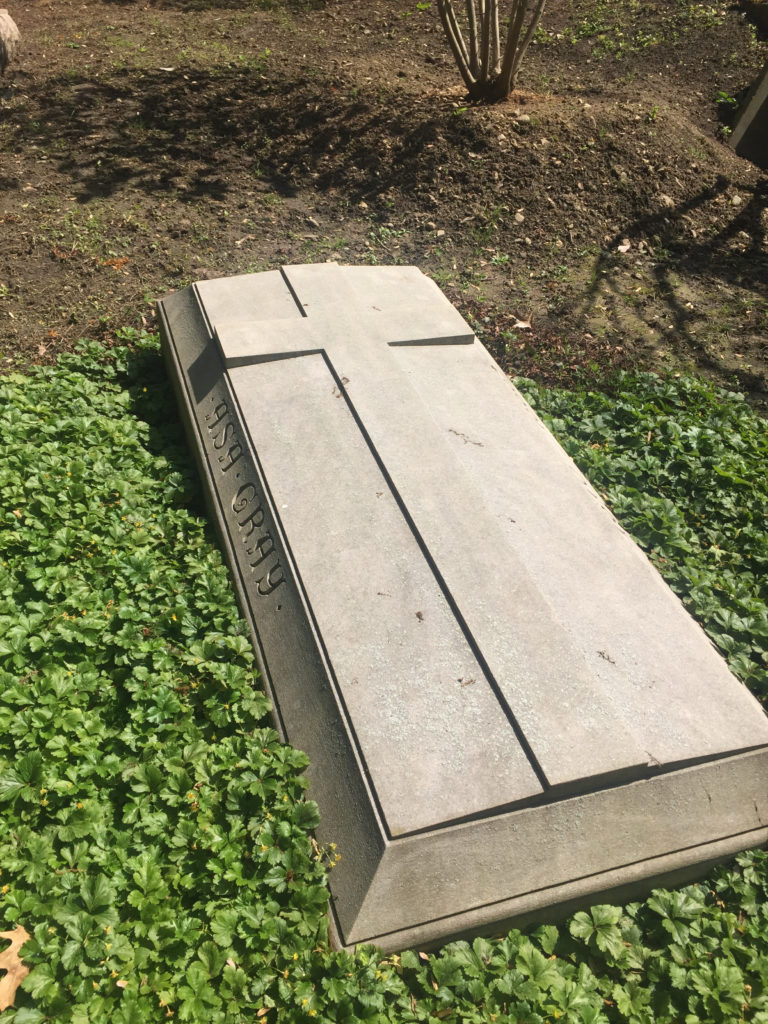Erik Visits an American Grave, Part 937
This is the grave of Asa Gray.

Born in 1810 in Sauquoit, New York, Gray grew up in the respectable farming class of the Early Republic. His father was a tanner, which required a lot of wood and thus led to deforestation. When the trees got too far away, he bought up a bunch of abandoned farms and did pretty well for himself. Gray devoured whatever books he could get. He went to a bunch of schools in the area and became interested primarily in plant life, which few people had studied to this time. He began to mount biological specimens and soon gained a reputation for their quality. He became a doctor in 1831, but he never really practiced medicine. Instead, he started tramping around the forests collecting plants. He could make ends meet by teaching school and then traveling in the summer. He moved to New York in 1836 to become the curator of the Lyceum of Natural History, which is now the New York Academy of Sciences.
Gray had wanted to go on the Wilkes Expedition, which when it finally got off the ground would be one of the most brutal and violent travels of Americans around the world in these years. But it took so long for it to get off the ground and Gray was so disgusted with the incompetence that he quit the project. Instead, he took a job at the newly created University of Michigan. But his job wasn’t so much teaching as it was going to Europe to buy books so the university could pretend like it was educating its students. He got to travel for the next few years, both building his biological specimens at his own expense and buying books. But it cost too much money so Michigan let him go in 1840 and he never taught there.
In 1841, Gray started working at Harvard. He didn’t have to teach much and so even though he didn’t make much money, he was mostly free to travel around and find plants. He produced textbooks and drew good illustrations for them at a time when this was largely unknown in American education. One can trace all of Gray’s trips here and there around the U.S. and Europe, but it gets a bit repetitive. Let’s just say he was on the road a lot and contributed a lot to classifying and understanding the botanical world. He gained an international reputation for his work. In 1859, he was elected to the Royal Swedish Academy of Sciences. In 1863, the American government, which I guess didn’t have anything else going on that year, created the National Academy of Sciences and Gray was one of the first 50 members. He received lots of other international accolades over the years as well.
Gray published a lot too. His first book was The Elements of Botany in 1836. He was a very technical writer and teacher and so struggled to communicate his ideas at times. He did manage to write a couple of high-school textbooks too, though it was a real pain for the publishers to get him to write in a way that regular people could understand. In fact, he was a bad teacher on top of this, unable to make himself understood to regular students.
Gray’s politics were pretty good. He hated slavery, believed in abolitionism, and was a staunch supporter of the North in the Civil War. He actually kind of wanted to join the military, even though he was 51 years old at the time, but then he manged to chop off part of his thumb in a garden accident. But he did join a group that guarded the Massachusetts State Arsenal in Cambridge, which evidently was under threat from Confederates or something.
Botany was always a pretty marginal subject in terms of student interest, which sadly it remains today. So it was difficult to both get funding from institutions, even something like Harvard, as well as to find quality botanists trained well enough to teach the subject. Gray was personally the center of botany in America. His home had the best species and so whoever wanted to come to the U.S. to work needed to visit Gray. He was simply botany in America.
Perhaps Gray’s greatest contribution was his support of Charles Darwin’s Theory of Evolution. He noticed the similarities between plants in east Asia and North America. He never quite figured out how this all worked out, but it proved to be important support material for the theory. Gray and Darwin were good friends, met when Gray was in Europe, and long corresponded. In fact, Gray collected specimens for Darwin on his trips to the American West. But Gray also couldn’t let go of religion and tried to convince Darwin that God was behind all of this, but Darwin wasn’t having it.
Gray had what was probably a series of strokes in 1887 and died in 1888. He was 77 years old.
Asa Gray is buried in Mount Auburn Cemetery, Cambridge, Massachusetts.
If you would like this series to visit other botanists, you can donate to cover the required expenses here. Emma Lucy Braun is in Cincinnati and Luther Burbank is in Santa Rosa, California. Previous posts in this series are archived here.


